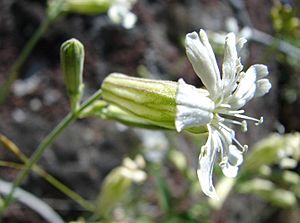Douglas's catchfly facts for kids
Quick facts for kids Douglas's catchfly |
|
|---|---|
 |
|
| Scientific classification | |
| Genus: |
Silene
|
| Species: |
douglasii
|
Silene douglasii is a type of flowering plant. It is often called Douglas's catchfly. This plant belongs to the Caryophyllaceae family, which includes many kinds of pinks and carnations. You can find it growing in western North America. Its home stretches from British Columbia in Canada down to California in the United States. It also grows as far east as Wyoming. This plant likes to live in different places. These include forests, woodlands, and even coastal areas near the sea.
About Douglas's Catchfly
Douglas's catchfly is a plant that lives for many years. It grows in clumps from a thick, branching base called a caudex. It also has a main root that goes deep into the ground, called a taproot. Its stems can lie flat on the ground or stand straight up. They can grow up to 70 centimeters (about 28 inches) long. The stems are covered in soft, gray-white hairs.
The leaves near the bottom of the stem are shaped like a spear. They can be up to 6 centimeters (about 2.4 inches) long. Leaves higher up on the stem are smaller.
Each flower is wrapped in a tube-shaped case. This case is called a calyx. It is made of special leaves called sepals. The calyx looks like a balloon and has ten green or reddish-purple lines. The top of the calyx is open. This opening shows five petals inside. The petals can be white, pink, or purplish. Each petal has two wide tips.
Different Kinds of Douglas's Catchfly
There are three main types, or varieties, of this plant:

